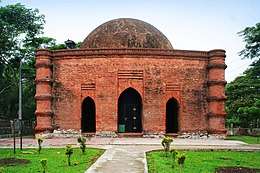Singar Mosque
The Singar Mosque (Bengali: সিঙ্গাইর মসজিদ)[note 1] is a 15th-century mosque which is part of the Mosque City of Bagerhat, a World Heritage Site in south-western Bangladesh. It is a single-domed, square building of exposed brick with terracotta decorations.
_(2).jpg)
Location
The Singar Mosque is part of the Mosque City of Bagerhat in south-western Bangladesh.[1] It is situated on the south side of the Bagerhat-Khulna Highway, about 200 metres (660 ft) south-east of the Sixty Dome Mosque.[2][3]
History
The mosque has no inscription by which it can be dated.[2] Architect Abu Sayeed M Ahmed estimates that it is from the 15th century.[4] Other experts believe, based on the known ages of stylistically similar local buildings, that it was built in the mid-15th century.[2][5][6] There is archaeological evidence that at one time the mosque compound was surrounded by a wall with towers at the corners and an entrance gate on the east.[5][7]
Banglapedia describes the mosque's condition in the early 1970s as "in utter ruin". The government's Department of Archaeology took over the site in 1975.[6] In 1984, archaeologist Johanna E. van Lohuizen de Leeuw wrote that the building had been partly restored, but "its corner towers are still in a shocking state".[7] The Mosque City of Bagerhat, of which Singar Mosque is a part, was inscribed on the list of World Heritage Sites in 1985.[1] The mosque was rated as being in a "fair state of preservation" in the 2010s.[6]
Architecture

The mosque is between 30 and 40 feet (9.1 and 12.2 m) square.[note 2] It has a single hemispherical dome. The entirety is constructed of brick. There are three doorways in the east, and one each in the north and south.[2] The central doorway in the east is higher and wider than the others.[9] The exterior of the west wall has a mihrab projection from the ground to the cornice.[5] At the four corners of the building are engaged circular towers which rise to roof level.[2][6] The cornice is gently curved, being 12 inches (0.30 m) higher at the center than at the ends.[9]
The doorways are pointed archways set within rectangular recesses,[2] at the top of which are several horizontal rows of terracotta ornamentation.[5] The corner towers are divided horizontally at regular intervals by raised bands. The cornice has two bands decorated with terracotta.[6]
The mosque's walls are 7 feet (2.1 m) thick.[5] The interior has a single mihrab in the qibla wall, on axis with the central entrance in the east. It is flanked by two decorated octagonal pilasters from which springs a multifoil arch with terracotta rosettes in the spandrels. All these are bordered by two rectangular frames, the space between which is filled with a four-petalled mesh in terracotta.[2][9] To each side of the mihrab is a multifoil arched niche in a rectangular recess. The north and south walls each have two similar, but smaller niches.[5][9]
Squinches spring from brick pilasters to support the base of the dome.[2]
Notes
- Transliterations vary. Signage on site spells it Singair. Perween Hasan uses Shingra and Banglapedia uses Singra, whereas most other sources use Singar.
- Naqi states that it is 30 feet 6 inches (9.30 m) square, Alamgir writes 35 feet 10 inches (10.92 m) square, and Banglapedia says, inclusive of the corner towers, 12.19 metres (40.0 ft) square.
References
- "Historic Mosque City of Bagerhat". World Heritage Convention. UNESCO. Retrieved 8 June 2020.
- Hasan, Perween (2007). Sultans and Mosques: The Early Muslim Architecture of Bangladesh. I.B. Tauris. pp. 125–127. ISBN 978-1-84511-381-0.
- "Singar Mosque". ArchNet. Retrieved 11 Oct 2019.
- Ahmed, Abu Sayeed M (2006). Mosque Architecture in Bangladesh (PDF). Dhaka: UNESCO. p. 205. ISBN 984-32-3469-3.
- Alamgir, Khoundkar (2008–2009). "Single Unit Square Type Sultanate Buildings of Bengal". Journal of Bengal Art. 13–14: 241.
- Bari, M. A. (2012). "Singra Mosque". In Islam, Sirajul; Jamal, Ahmed A. (eds.). Banglapedia: National Encyclopedia of Bangladesh (Second ed.). Asiatic Society of Bangladesh.
- van Lohuizen de Leeuw, Johanna E. (1984). "The early Muslim monuments at Bagerhat". In Michell, George (ed.). The Islamic Heritage of Bengal (PDF). UNESCO. p. 176. ISBN 92-3-102174-5.
- Hasan, Perween (2007). Sultans and Mosques: The Early Muslim Architecture of Bangladesh. I.B. Tauris. pp. 23, 49. ISBN 978-1-84511-381-0.
- Naqi, Md. Ali (March 2003). The Architecture of the Khan-e-Jahan Style: Context and Influence (PDF) (Masters of Architecture). Bangladesh University of Engineering and Technology. p. 83–84. Retrieved 8 June 2020.
External links

_002.jpg)